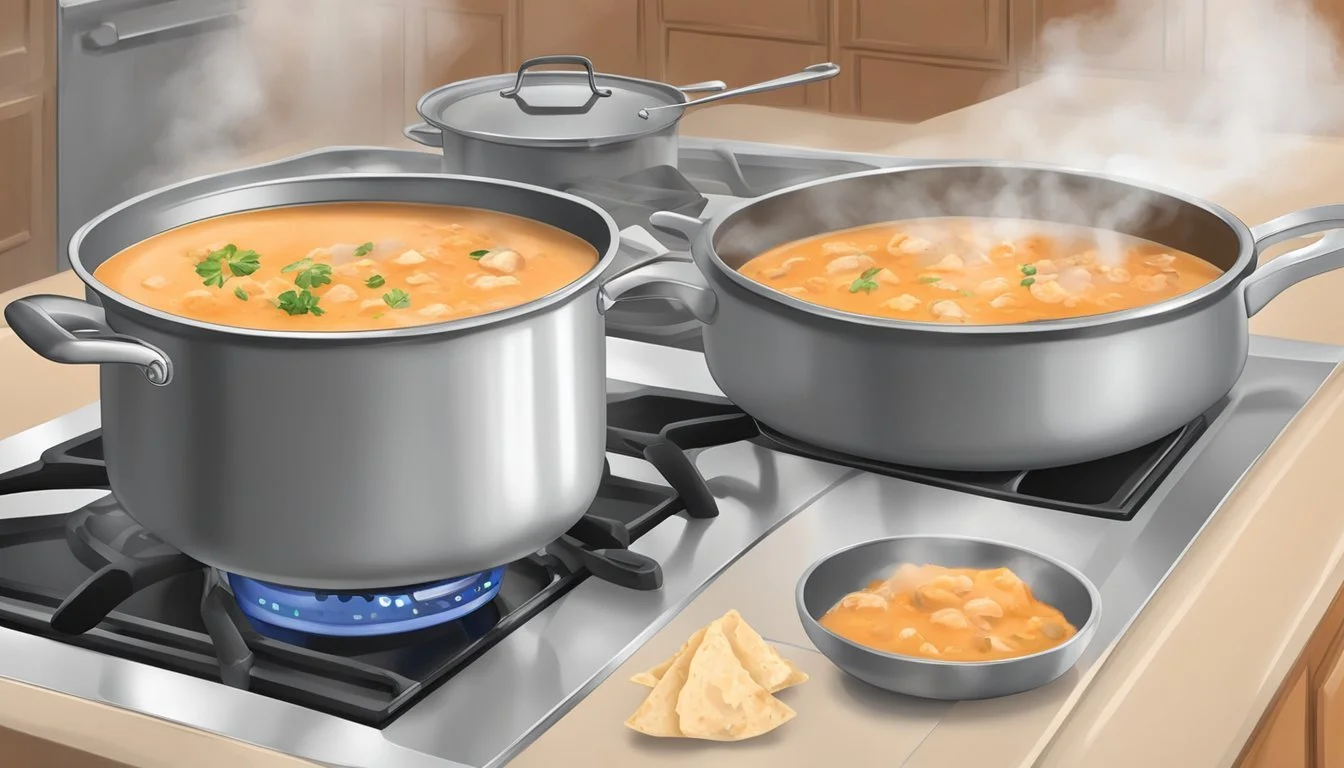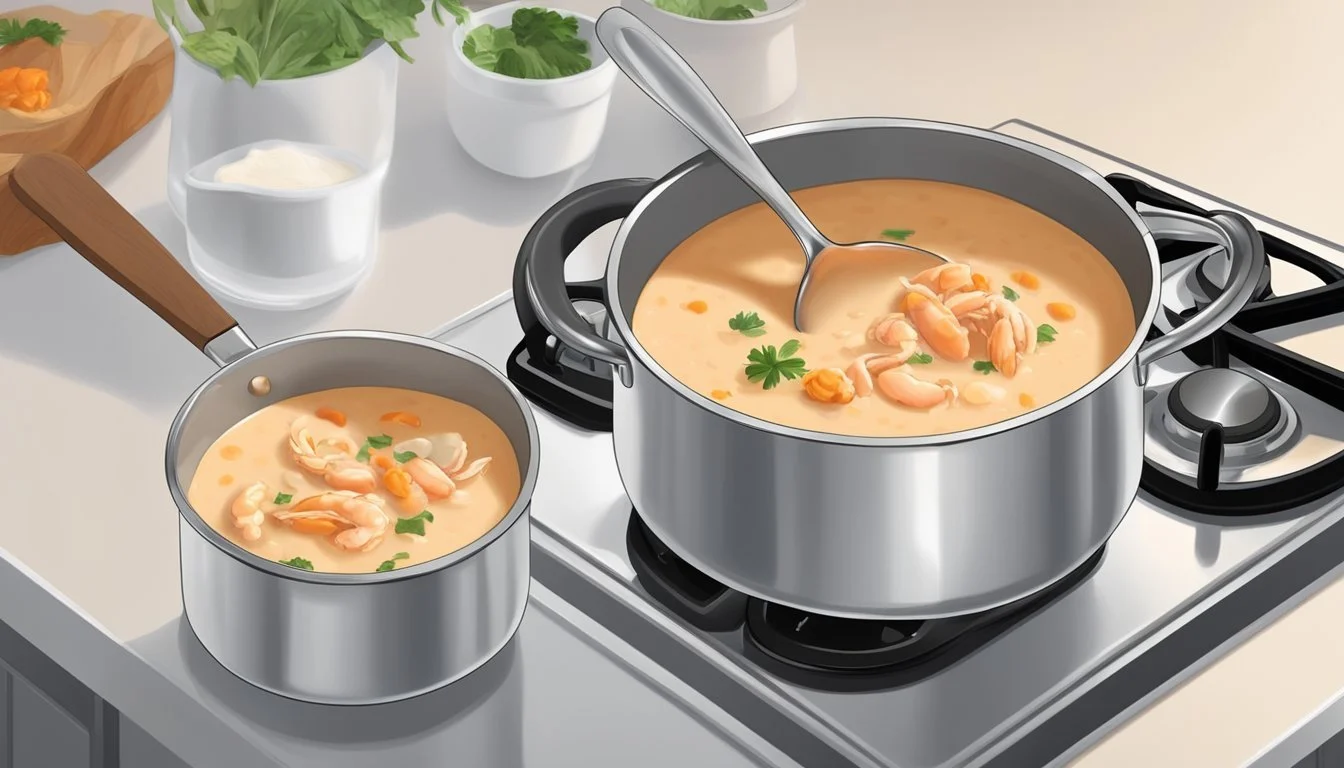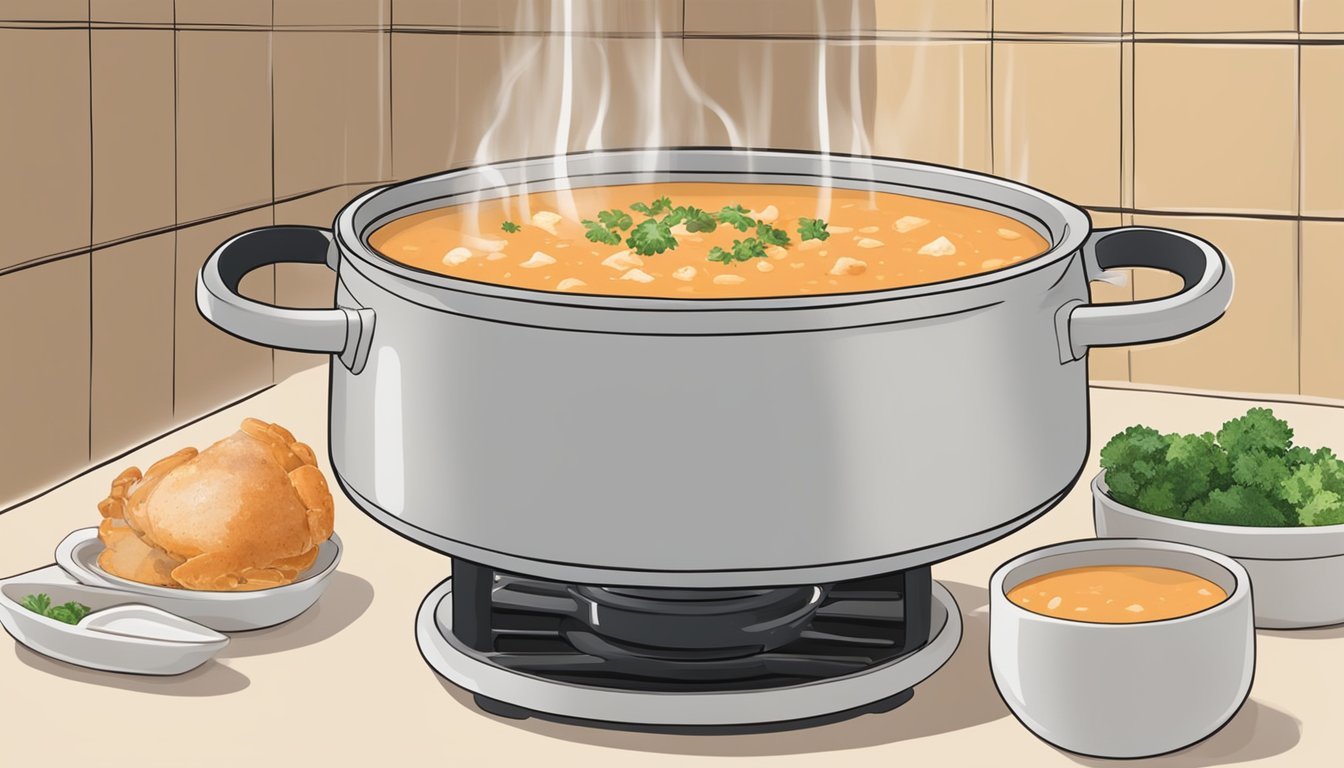Best Way to Reheat Crab Bisque
Ensuring Creaminess and Flavor Retention
Crab bisque, with its rich and creamy texture interspersed with generous chunks of succulent crab, is a seafood (What wine goes well with seafood?) delicacy that delights the palate. Known for its smooth, velvety soup base, it is a dish best served hot, bringing out the fullness of its flavors. However, the challenge arises when one has to reheat leftover bisque without compromising its creamy consistency or breaking down the delicate pieces of crab.
Maintaining the integrity of crab bisque during reheating requires a gentle approach. Direct, high heat can alter the soup's luxurious texture and can lead to the seafood becoming tough. It's important to understand the composition of the bisque, particularly the dairy elements, to prevent separation which can result in a less than appealing consistency.
A reheating method that is both gentle and gradual is key to preserving the bisque's creamy quality while keeping the crab meat intact. The method used should evenly distribute heat through the bisque, ensuring that it reaches a temperature that is hot enough for serving without overheating, which is crucial for a delicious, restaurant-quality result even after refrigeration.
Understanding Crab Bisque
Crab Bisque is a rich and creamy soup known for its deep seafood flavor and chunks of tender crab meat. This section will explore its origins, the quintessential ingredients that compose a classic bisque, and specifically, the importance of crab in this luxurious dish.
Definition of Bisque
Bisque is a smooth, creamy soup that originated in France and is made primarily from seafood. It's characterized by its use of heavy cream and a strained broth of highly concentrated flavor. Traditional techniques involve simmering crustacean shells to extract their full flavor, creating a rich base for the soup.
Key Ingredients
The foundation of any crab bisque involves a combination of the following key ingredients:
Seafood: The essence of bisque. It begins with the shells of crustaceans like crab or lobster to infuse the soup with a strong seafood flavor.
Crab Meat: Tender chunks of crab meat are essential for texture and enriching the soup's taste.
Heavy Cream: Adds the creamy, velvety consistency that bisque is celebrated for.
Butter: Used to sauté base vegetables and often to finish the bisque, providing a silky mouthfeel and depth of flavor.
Aromatics: Such as onions, celery, and garlic, which are sautéed to build the flavor profile.
Seasonings: Typically includes salt, pepper, and sometimes a hint of sherry to enhance the bisque's intricate flavors.
The Role of Crab in Bisque
Crab plays a pivotal role in bisque, not only contributing to the soup's name but also to its flavor and texture. The use of crab involves two key aspects:
Flavor: Crab shells, when simmered, release a delicate seafood flavor that is the heart of the bisque.
Texture: Generous pieces of crab meat are often added to the bisque to provide a pleasant contrast to the smooth soup, offering a chunky bite that is both satisfying and indicative of a high-quality bisque.
The crab is revered in bisque for its sweet, succulent taste that complements the rich and creamy soup base.
Preparation Before Reheating
Proper storage and understanding the ideal timing for reheating are crucial for maintaining the creamy texture and the integrity of the crab chunks in crab bisque.
Storing Leftover Bisque
After enjoying a heartwarming meal, leftover crab bisque should be dealt with promptly. To preserve its quality:
Allow the bisque to cool down to room temperature, but no longer than two hours to prevent bacteria growth.
Transfer the bisque into an airtight container. This will prevent odor absorption and flavor loss.
Place the container in the refrigerator if the bisque will be consumed within two days. For longer storage, freezing is an option; however, one must note that the cream base may separate or become grainy once thawed.
When to Reheat Crab Bisque
The best time to reheat crab bisque is within two days of storage in the refrigerator to maintain optimal flavor and texture. One must consider these guidelines:
Decide on reheating only the portion that will be eaten. Repeated reheating can degrade the bisque's quality.
If frozen, thaw the bisque in the refrigerator for several hours or overnight to ensure even heating later on.
Reheating Techniques
To maintain the delicate creaminess and the integrity of crab chunks in crab bisque during reheating, one must apply gentle heat and consistent stirring. Here are the effective methods to do so:
Stovetop Reheating Method
For stovetop reheating, the user should pour the bisque into a saucepan and warm it over medium-low heat. It is crucial to stir the bisque frequently with a wooden spoon to prevent any separation of the cream base and to keep the chunks of crab intact. The gentle and gradual heat will help preserve the bisque's smooth texture.
Microwave Reheating Method
Microwave reheating should be done cautiously to avoid overheating the bisque. Place the crab bisque in a microwave-safe container, covering it with a lid or microwave-safe plastic wrap to trap steam and encourage even heating. The user should microwave the bisque on medium power in 30-second bursts, stirring in between each burst to maintain creaminess and prevent hotspots from forming.
Oven Reheating Method
Oven reheating is less common for bisque but can be done effectively. Preheat the oven to a low temperature, around 275°F (135°C), to avoid scorching the bisque. The bisque should be placed in an oven-safe dish, covered with foil to retain moisture. Heat it for 10-15 minutes, checking and stirring at five-minute intervals to ensure the crab bisque heats evenly and maintains its creamy consistency.
Maintaining Creaminess and Texture
When reheating crab bisque, preserving its velvety texture and sumptuous creaminess is paramount. Proper heat management and stirring techniques are essential.
Controlling the Heat
The key to maintaining the creaminess of crab bisque lies in controlling the heat. One should reheat the bisque over low to medium heat, avoiding high temperatures that can cause the ingredients to separate. The bisque should be heated until it is just hot enough to serve, which typically means reaching a temperature where it begins to steam lightly but does not come to a boil.
Stirring Techniques
Stirring plays a crucial role in preserving the texture of the bisque. It should be done gently and frequently to ensure even heating. A wooden spoon or silicone spatula is best to prevent the delicate crab meat from breaking apart while stirring. The goal is to maintain a smooth and homogenous consistency throughout the reheating process.
Avoiding Overcooking
To avoid overcooking, which can lead to a loss of the bisque's signature velvety texture, one must be attentive to the bisque's changing texture as it heats. Overcooking can also toughen the crab pieces, spoiling the bisque's indulgent quality. It's crucial to heat the bisque only until the crab meat is warmed through, typically taking no more than a few minutes. Once the bisque reaches the ideal temperature, it should be removed from the heat source immediately to prevent further cooking.
Seasoning Adjustments
When reheating crab bisque, the balance of seasoning is critical to ensure the bisque retains its signature flavor. Subtle tweaks in seasoning can make a considerable difference.
Tasting and Adjusting Salinity
Before serving reheated crab bisque, one should take a moment to taste and assess its salinity. Over time, flavors can diminish or evolve, so a small pinch of salt can restore the bisque's original profile. If necessary, increase saltiness gradually to avoid overpowering the delicate crab flavor. Conversely, if the bisque is overly salty after reheating, adding a touch more cream or broth can help temper it.
Enhancing Creamy Crab Bisque with Herbs and Spices
To elevate the reheated crab bisque, incorporating herbs and spices is essential. Freshly ground black pepper can add a nuanced heat, while specific spice blends like Old Bay seasoning lend a traditional seafood savor. Herbs such as parsley or dill, added after reheating, can introduce a fresh dimension. Use these seasonings judiciously, aiming to complement, not mask, the creamy sweetness of the crab.
Serving and Pairing Suggestions
To elevate the enjoyment of crab bisque, carefully select side dishes and wine pairings that complement its rich flavor and creamy texture.
Appropriate Side Dishes
Baguette: A freshly baked baguette, sliced and perhaps toasted, offers a delightful crunch and is perfect for sopping up the bisque.
Salad: A light, lemony arugula salad sprinkled with parsley brings a fresh, peppery contrast to the rich soup.
Wine Pairings
Amontillado Sherry: A medium-bodied sherry with nutty undertones balances the creaminess of the bisque.
Oloroso Sherry: For a robust contrast, choose an Oloroso sherry with caramel-like notes to play off the delicate crab flavor.
Nutritional Considerations
When reheating crab bisque, one must consider the nutritional impact of the dish, particularly focusing on its caloric and fatty content. The section below outlines how the creamy soup contains significant calories and fats and offers suggestions for ingredient substitutions to accommodate different dietary needs.
Caloric and Fatty Content
Crab bisque can be rich in calories and fat, as it is typically made with cream and butter. A standard serving of crab bisque might contain:
Calories: Approximately 200-300 kcal
Fat: 15-20 grams
Cholesterol: 50-100 mg
Protein: 10-15 grams
Sodium: 300-500 mg
These values can vary widely based on the recipe and portion size. Individuals monitoring their caloric intake or managing cardiovascular considerations should be aware of the creamy nature of the bisque, which contributes to its higher fat content.
Alternative Ingredients for Dietary Needs
For those with dietary constraints or preferences, it's possible to substitute certain ingredients to align with their needs:
Replace full-fat cream with low-fat milk or non-dairy alternatives such as almond or soy milk.
Opt for low-sodium broth to reduce the sodium content.
Use olive oil in place of butter for a boost of monounsaturated fats.
Incorporate plant-based thickeners, such as pureed vegetables, for a healthier twist and to maintain creaminess without excessive fat.
By considering alternative ingredients, one can tailor crab bisque to fit specific dietary requirements while still preserving its delicious and comforting qualities.
Common Mistakes to Avoid
When striving to reheat crab bisque, it is crucial to preserve its characteristic creaminess and the delicate chunks of crab that distinguish it. Care should be taken to maintain the integrity of the soup's texture and flavor profile.
Reheating at High Temperatures
One should never reheat crab bisque at high temperatures as it risks breaking the bisque's emulsion, leading to a gritty texture rather than the desired creamy consistency. The soup should be gently warmed on a low heat setting to prevent it from separating or the proteins in the crab from becoming tough.
Proper Technique: Heat on a low setting, stirring occasionally.
Temperature Range: Ideally, keep it between low to medium-low heat.
Excessive Seasoning
Adding too much seasoning, especially when reheating, can overpower the delicate balance of herbs and spices already present in the bisque. Instead, one should focus on enhancing the existing flavors rather than introducing an abundance of additional spices.
Herbs and Spices: Use sparingly to enhance, not dominate.
Taste Test: Always taste before adjusting seasoning to avoid a rubbery texture from too much salt.
Understanding Seafood Stocks
The foundation of a rich and flavorful crab bisque lies in the quality of the seafood stock used. A good stock contributes to the soup’s depth of flavor and complements the creamy texture and crab chunks.
Making Homemade Seafood Stock
Homemade seafood stock begins with the basics: crab shells and shellfish remnants. These ingredients are essential as they imbue the stock with a strong and authentic seafood flavor that is hard to replicate with substitutes.
Ingredients:
Crab shells
Aromatic vegetables (onions, carrots, celery)
Herbs (parsley, thyme)
Seasonings (whole peppercorns, bay leaf)
Preparation Steps:
Clean the crab shells thoroughly to remove any unwanted debris.
Sauté your choice of aromatic vegetables until they are soft.
Combine the vegetables with crab shells and cover with water.
Simmer gently for an hour to coax out the flavors, skimming off any impurities that rise to the surface.
Strain the resulting broth through a fine mesh sieve for clarity.
Substituting with Store-Bought Stocks
For those lacking time or resources to make homemade stock, store-bought stocks are a convenient alternative. It is crucial to select a high-quality store-bought stock that is as close to homemade as possible. Broths are different from stocks due to their seasoning; they're typically salted and can alter the flavor profile of the bisque.
Considerations for Store-Bought Stocks:
Flavor: Choose unsalted or low-sodium options to better control the seasoning in your bisque.
Ingredients: Look for a stock with a minimal and recognizable ingredient list, avoiding additives and preservatives.
When using store-bought stocks, one might also enhance the stock by simmering it with additional crab shells or shellfish remnants, if available, to amplify the seafood flavor.
Final Thoughts
When reheating crab bisque, one should always aim to retain the soup's luxurious creaminess and the integrity of the crab chunks. It's an indulgent dish, where each spoonful should offer a rich, velvety texture paired with substantial pieces of crab meat.
A reheated crab bisque can rival the initial serving if done with care. The priority is gentle heat; a microwave might be too harsh, risking a separated or grainy bisque. Instead, a low and slow approach on the stove is advisable. Stirring occasionally helps maintain an even temperature throughout.
Consistency is key:
Start on a low flame.
Stir to prevent sticking.
Temperature is crucial:
Avoid boiling; it’s sufficient to heat until just steaming.
Serving is about preservation:
Serve immediately once the bisque reaches the appropriate warmth.
When looking at ratings or reviews for a crab bisque recipe, pay close attention to how well the bisque holds up upon reheating, checking comments on texture and flavor retention. Those details can be as telling as the original preparation instructions.
In summary, the best way to reheat creamy crab bisque is with attention to heat and method. This ensures the end result is as close to the original experience as possible, keeping the indulgence intact for repeat servings.









